HSC698 Capstone Project: Queenan Health System HRO Operational Plan
VerifiedAdded on 2023/03/17
|12
|3395
|22
Project
AI Summary
This project analyzes the Queenan Health System's HRO (High Reliability Organization) operational plan, focusing on the application of the American College of Healthcare Executives Leadership Domains to transform the organization. The project addresses the increasing risks associated with pregnancy and aims to identify and mitigate potential complications. It outlines objectives such as creating highly reliable organizations, promoting sensitivity to actions, and avoiding simple explanations for problems. The plan emphasizes the importance of employee engagement, skill development, and a culture of continuous improvement. Training techniques and leadership evaluations are also discussed to achieve resilience and enhance the decision-making process within the healthcare system. The study also explores the application of the HRO framework to various aspects of the healthcare system, including staff training and leadership development, to create a safer and more efficient healthcare environment. This project aims to improve the quality of care and reduce the cost of health care for the patients.
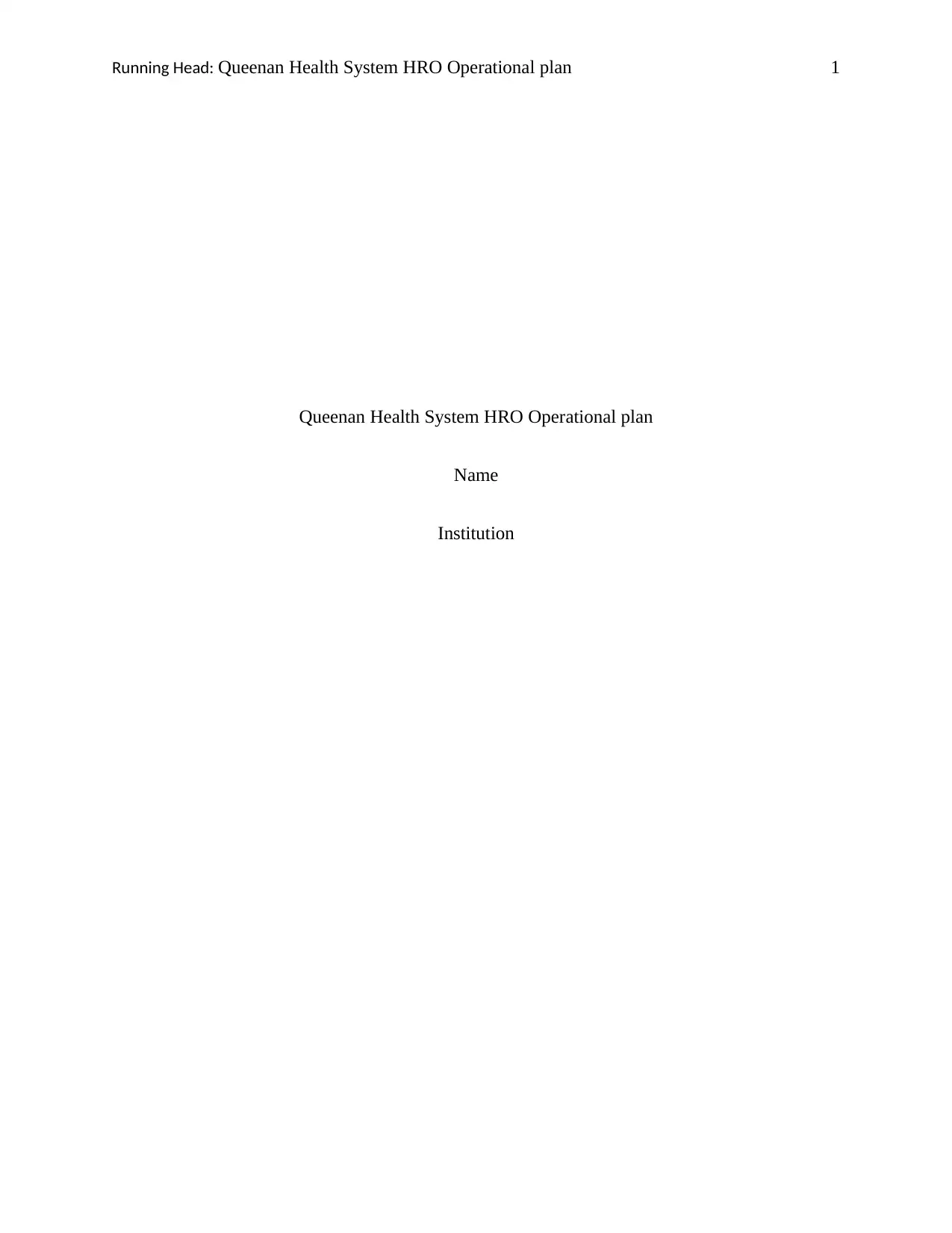
Running Head: Queenan Health System HRO Operational plan 1
Queenan Health System HRO Operational plan
Name
Institution
Queenan Health System HRO Operational plan
Name
Institution
Paraphrase This Document
Need a fresh take? Get an instant paraphrase of this document with our AI Paraphraser
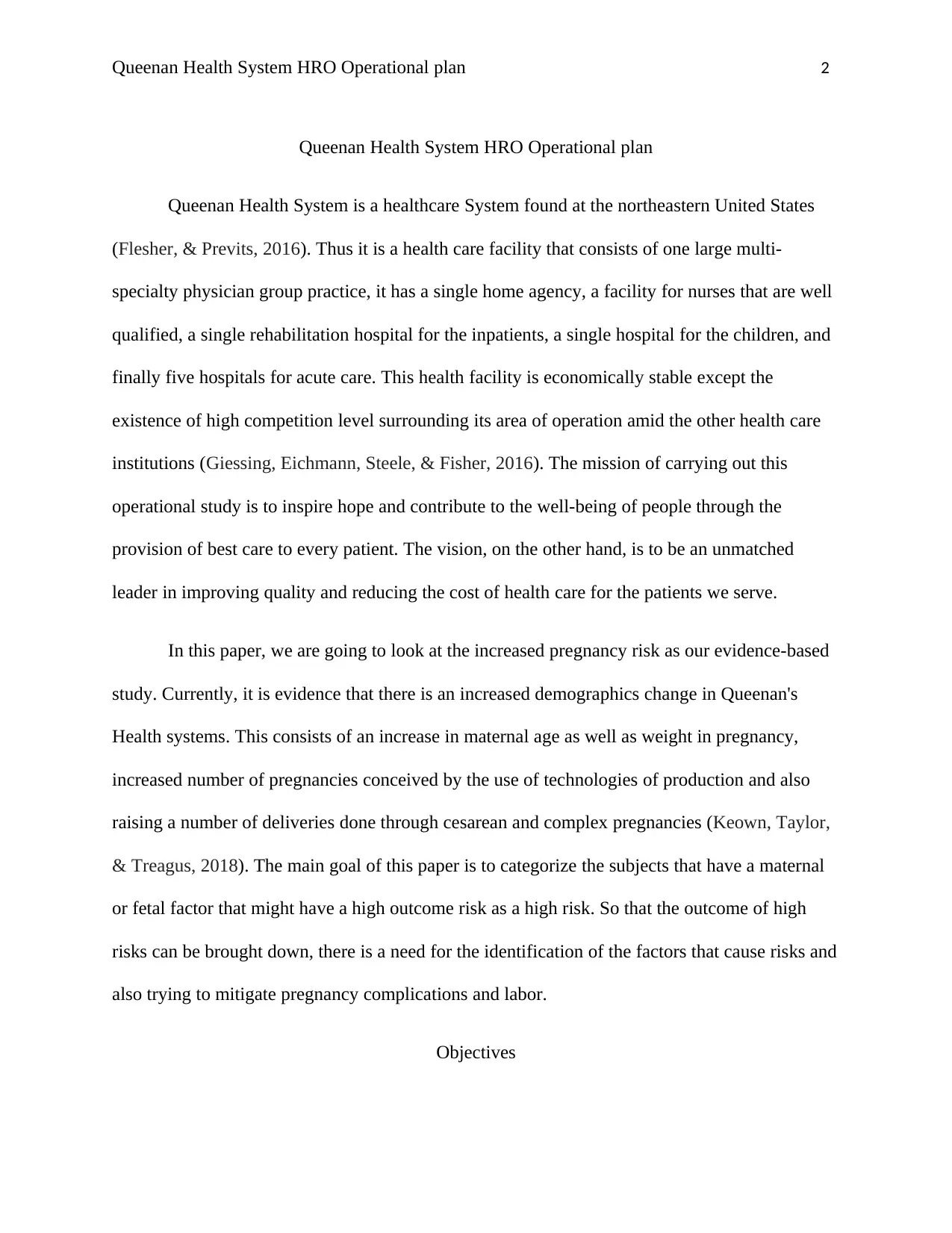
Queenan Health System HRO Operational plan 2
Queenan Health System HRO Operational plan
Queenan Health System is a healthcare System found at the northeastern United States
(Flesher, & Previts, 2016). Thus it is a health care facility that consists of one large multi-
specialty physician group practice, it has a single home agency, a facility for nurses that are well
qualified, a single rehabilitation hospital for the inpatients, a single hospital for the children, and
finally five hospitals for acute care. This health facility is economically stable except the
existence of high competition level surrounding its area of operation amid the other health care
institutions (Giessing, Eichmann, Steele, & Fisher, 2016). The mission of carrying out this
operational study is to inspire hope and contribute to the well-being of people through the
provision of best care to every patient. The vision, on the other hand, is to be an unmatched
leader in improving quality and reducing the cost of health care for the patients we serve.
In this paper, we are going to look at the increased pregnancy risk as our evidence-based
study. Currently, it is evidence that there is an increased demographics change in Queenan's
Health systems. This consists of an increase in maternal age as well as weight in pregnancy,
increased number of pregnancies conceived by the use of technologies of production and also
raising a number of deliveries done through cesarean and complex pregnancies (Keown, Taylor,
& Treagus, 2018). The main goal of this paper is to categorize the subjects that have a maternal
or fetal factor that might have a high outcome risk as a high risk. So that the outcome of high
risks can be brought down, there is a need for the identification of the factors that cause risks and
also trying to mitigate pregnancy complications and labor.
Objectives
Queenan Health System HRO Operational plan
Queenan Health System is a healthcare System found at the northeastern United States
(Flesher, & Previts, 2016). Thus it is a health care facility that consists of one large multi-
specialty physician group practice, it has a single home agency, a facility for nurses that are well
qualified, a single rehabilitation hospital for the inpatients, a single hospital for the children, and
finally five hospitals for acute care. This health facility is economically stable except the
existence of high competition level surrounding its area of operation amid the other health care
institutions (Giessing, Eichmann, Steele, & Fisher, 2016). The mission of carrying out this
operational study is to inspire hope and contribute to the well-being of people through the
provision of best care to every patient. The vision, on the other hand, is to be an unmatched
leader in improving quality and reducing the cost of health care for the patients we serve.
In this paper, we are going to look at the increased pregnancy risk as our evidence-based
study. Currently, it is evidence that there is an increased demographics change in Queenan's
Health systems. This consists of an increase in maternal age as well as weight in pregnancy,
increased number of pregnancies conceived by the use of technologies of production and also
raising a number of deliveries done through cesarean and complex pregnancies (Keown, Taylor,
& Treagus, 2018). The main goal of this paper is to categorize the subjects that have a maternal
or fetal factor that might have a high outcome risk as a high risk. So that the outcome of high
risks can be brought down, there is a need for the identification of the factors that cause risks and
also trying to mitigate pregnancy complications and labor.
Objectives
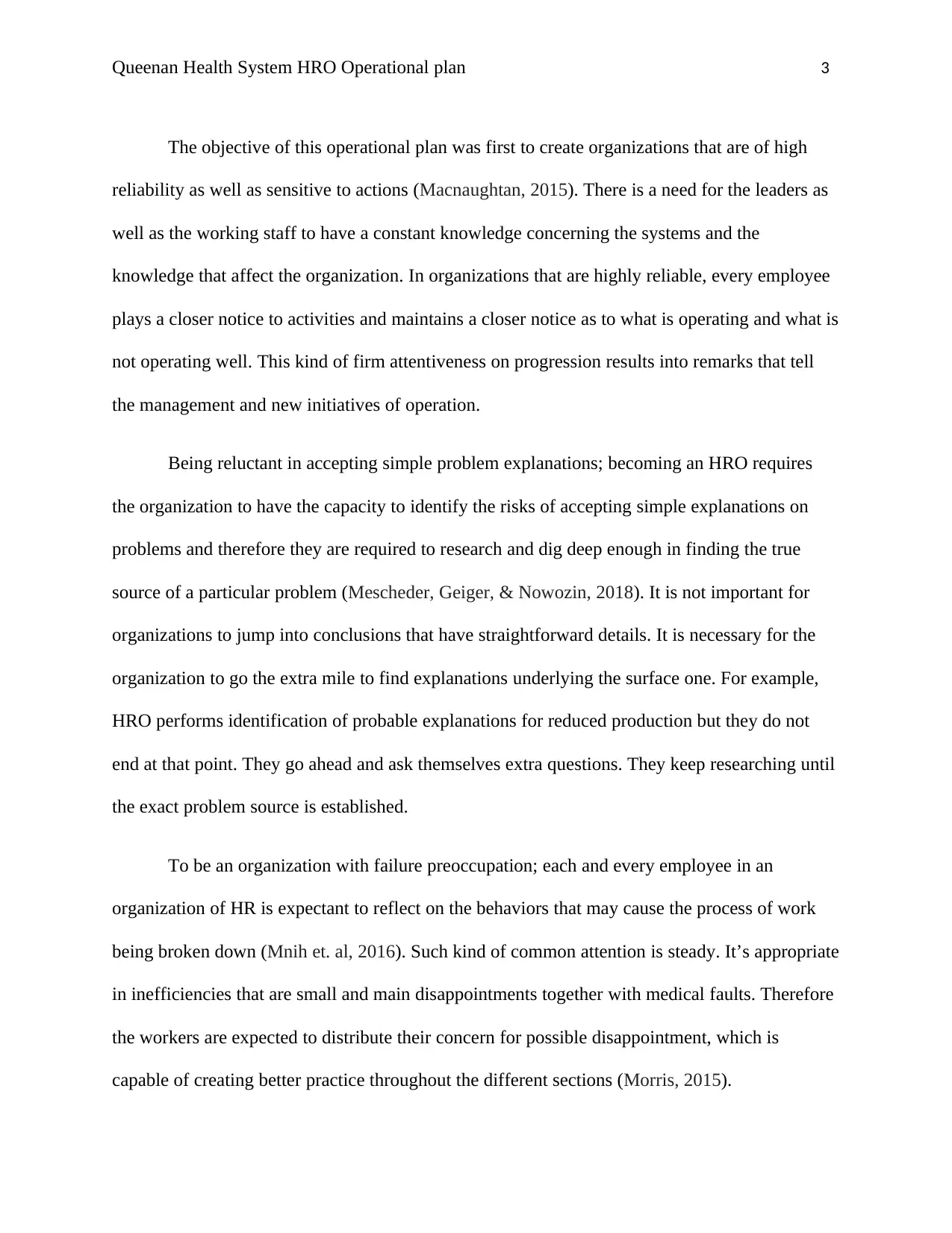
Queenan Health System HRO Operational plan 3
The objective of this operational plan was first to create organizations that are of high
reliability as well as sensitive to actions (Macnaughtan, 2015). There is a need for the leaders as
well as the working staff to have a constant knowledge concerning the systems and the
knowledge that affect the organization. In organizations that are highly reliable, every employee
plays a closer notice to activities and maintains a closer notice as to what is operating and what is
not operating well. This kind of firm attentiveness on progression results into remarks that tell
the management and new initiatives of operation.
Being reluctant in accepting simple problem explanations; becoming an HRO requires
the organization to have the capacity to identify the risks of accepting simple explanations on
problems and therefore they are required to research and dig deep enough in finding the true
source of a particular problem (Mescheder, Geiger, & Nowozin, 2018). It is not important for
organizations to jump into conclusions that have straightforward details. It is necessary for the
organization to go the extra mile to find explanations underlying the surface one. For example,
HRO performs identification of probable explanations for reduced production but they do not
end at that point. They go ahead and ask themselves extra questions. They keep researching until
the exact problem source is established.
To be an organization with failure preoccupation; each and every employee in an
organization of HR is expectant to reflect on the behaviors that may cause the process of work
being broken down (Mnih et. al, 2016). Such kind of common attention is steady. It’s appropriate
in inefficiencies that are small and main disappointments together with medical faults. Therefore
the workers are expected to distribute their concern for possible disappointment, which is
capable of creating better practice throughout the different sections (Morris, 2015).
The objective of this operational plan was first to create organizations that are of high
reliability as well as sensitive to actions (Macnaughtan, 2015). There is a need for the leaders as
well as the working staff to have a constant knowledge concerning the systems and the
knowledge that affect the organization. In organizations that are highly reliable, every employee
plays a closer notice to activities and maintains a closer notice as to what is operating and what is
not operating well. This kind of firm attentiveness on progression results into remarks that tell
the management and new initiatives of operation.
Being reluctant in accepting simple problem explanations; becoming an HRO requires
the organization to have the capacity to identify the risks of accepting simple explanations on
problems and therefore they are required to research and dig deep enough in finding the true
source of a particular problem (Mescheder, Geiger, & Nowozin, 2018). It is not important for
organizations to jump into conclusions that have straightforward details. It is necessary for the
organization to go the extra mile to find explanations underlying the surface one. For example,
HRO performs identification of probable explanations for reduced production but they do not
end at that point. They go ahead and ask themselves extra questions. They keep researching until
the exact problem source is established.
To be an organization with failure preoccupation; each and every employee in an
organization of HR is expectant to reflect on the behaviors that may cause the process of work
being broken down (Mnih et. al, 2016). Such kind of common attention is steady. It’s appropriate
in inefficiencies that are small and main disappointments together with medical faults. Therefore
the workers are expected to distribute their concern for possible disappointment, which is
capable of creating better practice throughout the different sections (Morris, 2015).
⊘ This is a preview!⊘
Do you want full access?
Subscribe today to unlock all pages.

Trusted by 1+ million students worldwide
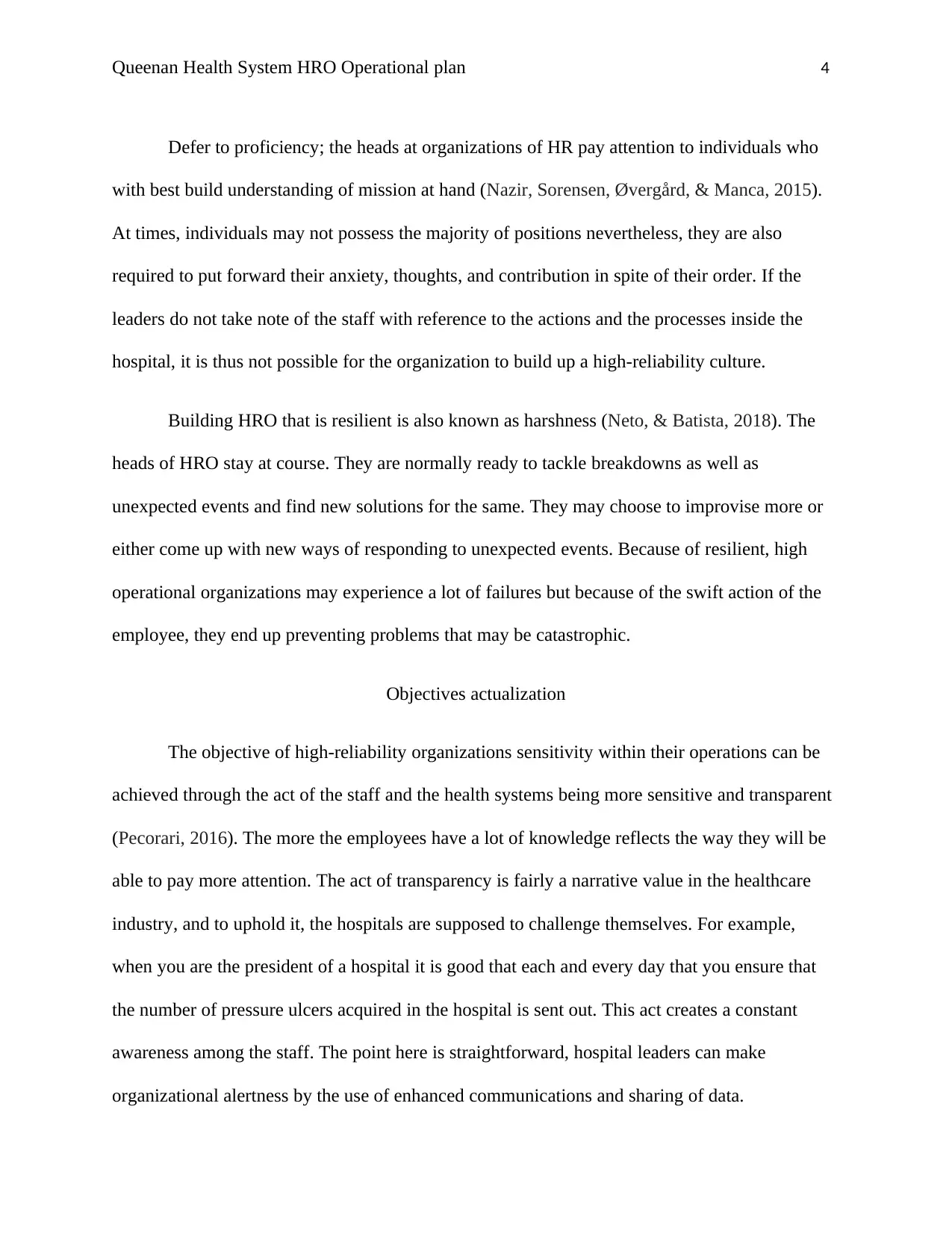
Queenan Health System HRO Operational plan 4
Defer to proficiency; the heads at organizations of HR pay attention to individuals who
with best build understanding of mission at hand (Nazir, Sorensen, Øvergård, & Manca, 2015).
At times, individuals may not possess the majority of positions nevertheless, they are also
required to put forward their anxiety, thoughts, and contribution in spite of their order. If the
leaders do not take note of the staff with reference to the actions and the processes inside the
hospital, it is thus not possible for the organization to build up a high-reliability culture.
Building HRO that is resilient is also known as harshness (Neto, & Batista, 2018). The
heads of HRO stay at course. They are normally ready to tackle breakdowns as well as
unexpected events and find new solutions for the same. They may choose to improvise more or
either come up with new ways of responding to unexpected events. Because of resilient, high
operational organizations may experience a lot of failures but because of the swift action of the
employee, they end up preventing problems that may be catastrophic.
Objectives actualization
The objective of high-reliability organizations sensitivity within their operations can be
achieved through the act of the staff and the health systems being more sensitive and transparent
(Pecorari, 2016). The more the employees have a lot of knowledge reflects the way they will be
able to pay more attention. The act of transparency is fairly a narrative value in the healthcare
industry, and to uphold it, the hospitals are supposed to challenge themselves. For example,
when you are the president of a hospital it is good that each and every day that you ensure that
the number of pressure ulcers acquired in the hospital is sent out. This act creates a constant
awareness among the staff. The point here is straightforward, hospital leaders can make
organizational alertness by the use of enhanced communications and sharing of data.
Defer to proficiency; the heads at organizations of HR pay attention to individuals who
with best build understanding of mission at hand (Nazir, Sorensen, Øvergård, & Manca, 2015).
At times, individuals may not possess the majority of positions nevertheless, they are also
required to put forward their anxiety, thoughts, and contribution in spite of their order. If the
leaders do not take note of the staff with reference to the actions and the processes inside the
hospital, it is thus not possible for the organization to build up a high-reliability culture.
Building HRO that is resilient is also known as harshness (Neto, & Batista, 2018). The
heads of HRO stay at course. They are normally ready to tackle breakdowns as well as
unexpected events and find new solutions for the same. They may choose to improvise more or
either come up with new ways of responding to unexpected events. Because of resilient, high
operational organizations may experience a lot of failures but because of the swift action of the
employee, they end up preventing problems that may be catastrophic.
Objectives actualization
The objective of high-reliability organizations sensitivity within their operations can be
achieved through the act of the staff and the health systems being more sensitive and transparent
(Pecorari, 2016). The more the employees have a lot of knowledge reflects the way they will be
able to pay more attention. The act of transparency is fairly a narrative value in the healthcare
industry, and to uphold it, the hospitals are supposed to challenge themselves. For example,
when you are the president of a hospital it is good that each and every day that you ensure that
the number of pressure ulcers acquired in the hospital is sent out. This act creates a constant
awareness among the staff. The point here is straightforward, hospital leaders can make
organizational alertness by the use of enhanced communications and sharing of data.
Paraphrase This Document
Need a fresh take? Get an instant paraphrase of this document with our AI Paraphraser

Queenan Health System HRO Operational plan 5
The objective of being reluctant in accepting simple explanations for problems can be
accomplished by the act of the leaders looking for data that confront their trust as to the reason
behind the existent of certain problems (Rumpf, Lockie, Cronin, & Jalilvand, 2016). There is a
scenario where the workers in a certain health care center were attributing little patient skill
scores to a high number of admitted patients from the emergency department. At first, it was said
that this cause looked reasonable and sound. It might swiftly strengthen itself as an essential
belief all through the organization, hence making the workers less liable to alter them to develop
patient experience scores. It is also evident that people admitted to the hospital through ED were
seen to have a likely hood of being prepared for a longer time or other operational times and
issues.
On the other hand, admitted patients from direct referral had an expectation that swift and
seamless admission process, only to be dissatisfied when such didn’t happen. From this, we learn
that in order for an organization to become a high-reliability organization, there is a need for
hospital organizations to go down to their metrics, make a comparison between information and
explanations on questions that appears to be obvious and reasonable because the reverse might
be correct (Wagner, & Ng, 2019).
The objective of preoccupation with failure can be achieved through the discovery of
things that are not running properly. Taking an example when a bad implementation happens in
organizations of high reliability, the head in the organization doesn't stop there. As an alternative,
they look for an alternative place inside the association wherever a similar operation is running
efficiently (Ziv, 2017). People tend to have improved problem diagnosis when they find some
achievement. This is the reason you hear them asking “how can we do it in this department but
The objective of being reluctant in accepting simple explanations for problems can be
accomplished by the act of the leaders looking for data that confront their trust as to the reason
behind the existent of certain problems (Rumpf, Lockie, Cronin, & Jalilvand, 2016). There is a
scenario where the workers in a certain health care center were attributing little patient skill
scores to a high number of admitted patients from the emergency department. At first, it was said
that this cause looked reasonable and sound. It might swiftly strengthen itself as an essential
belief all through the organization, hence making the workers less liable to alter them to develop
patient experience scores. It is also evident that people admitted to the hospital through ED were
seen to have a likely hood of being prepared for a longer time or other operational times and
issues.
On the other hand, admitted patients from direct referral had an expectation that swift and
seamless admission process, only to be dissatisfied when such didn’t happen. From this, we learn
that in order for an organization to become a high-reliability organization, there is a need for
hospital organizations to go down to their metrics, make a comparison between information and
explanations on questions that appears to be obvious and reasonable because the reverse might
be correct (Wagner, & Ng, 2019).
The objective of preoccupation with failure can be achieved through the discovery of
things that are not running properly. Taking an example when a bad implementation happens in
organizations of high reliability, the head in the organization doesn't stop there. As an alternative,
they look for an alternative place inside the association wherever a similar operation is running
efficiently (Ziv, 2017). People tend to have improved problem diagnosis when they find some
achievement. This is the reason you hear them asking “how can we do it in this department but
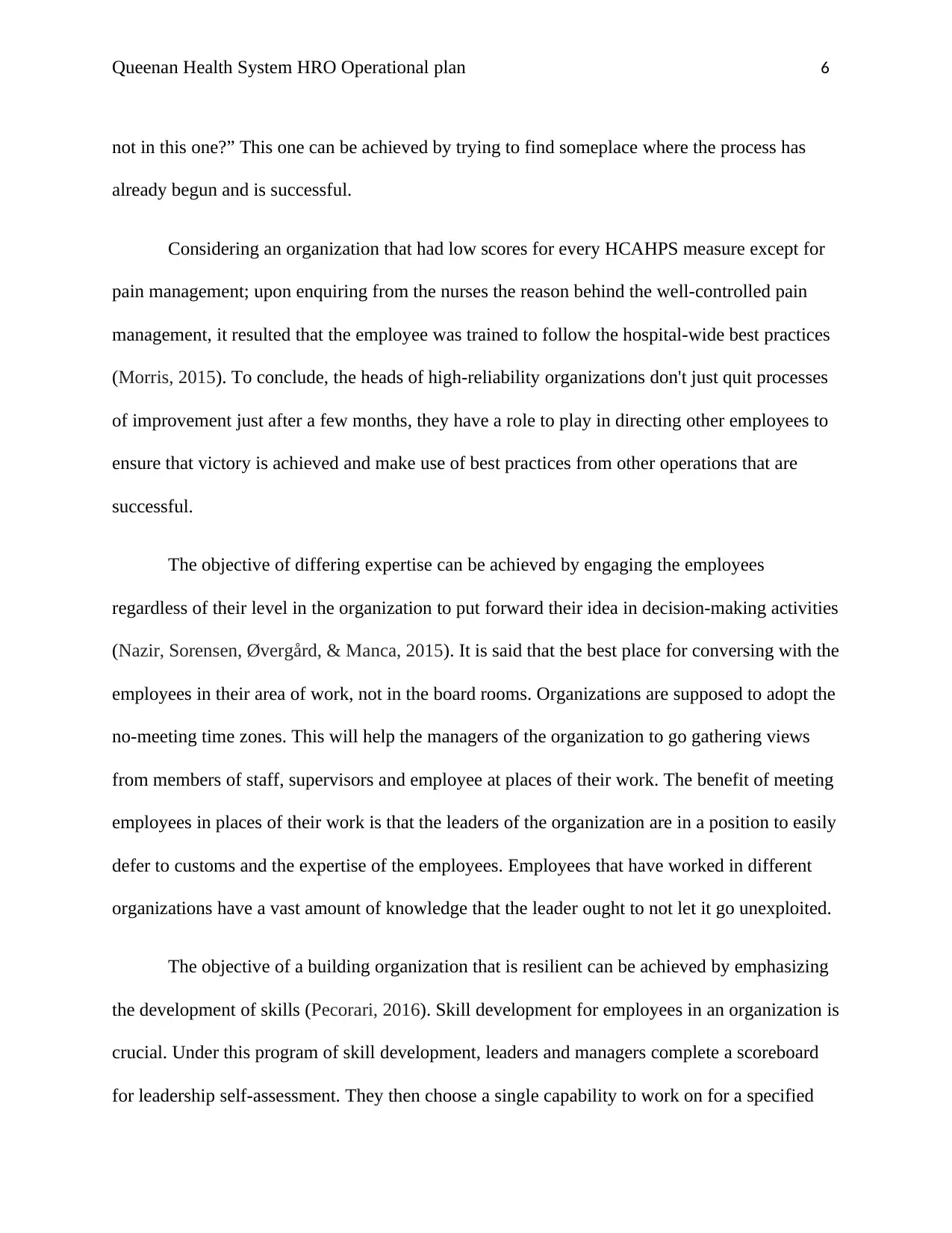
Queenan Health System HRO Operational plan 6
not in this one?” This one can be achieved by trying to find someplace where the process has
already begun and is successful.
Considering an organization that had low scores for every HCAHPS measure except for
pain management; upon enquiring from the nurses the reason behind the well-controlled pain
management, it resulted that the employee was trained to follow the hospital-wide best practices
(Morris, 2015). To conclude, the heads of high-reliability organizations don't just quit processes
of improvement just after a few months, they have a role to play in directing other employees to
ensure that victory is achieved and make use of best practices from other operations that are
successful.
The objective of differing expertise can be achieved by engaging the employees
regardless of their level in the organization to put forward their idea in decision-making activities
(Nazir, Sorensen, Øvergård, & Manca, 2015). It is said that the best place for conversing with the
employees in their area of work, not in the board rooms. Organizations are supposed to adopt the
no-meeting time zones. This will help the managers of the organization to go gathering views
from members of staff, supervisors and employee at places of their work. The benefit of meeting
employees in places of their work is that the leaders of the organization are in a position to easily
defer to customs and the expertise of the employees. Employees that have worked in different
organizations have a vast amount of knowledge that the leader ought to not let it go unexploited.
The objective of a building organization that is resilient can be achieved by emphasizing
the development of skills (Pecorari, 2016). Skill development for employees in an organization is
crucial. Under this program of skill development, leaders and managers complete a scoreboard
for leadership self-assessment. They then choose a single capability to work on for a specified
not in this one?” This one can be achieved by trying to find someplace where the process has
already begun and is successful.
Considering an organization that had low scores for every HCAHPS measure except for
pain management; upon enquiring from the nurses the reason behind the well-controlled pain
management, it resulted that the employee was trained to follow the hospital-wide best practices
(Morris, 2015). To conclude, the heads of high-reliability organizations don't just quit processes
of improvement just after a few months, they have a role to play in directing other employees to
ensure that victory is achieved and make use of best practices from other operations that are
successful.
The objective of differing expertise can be achieved by engaging the employees
regardless of their level in the organization to put forward their idea in decision-making activities
(Nazir, Sorensen, Øvergård, & Manca, 2015). It is said that the best place for conversing with the
employees in their area of work, not in the board rooms. Organizations are supposed to adopt the
no-meeting time zones. This will help the managers of the organization to go gathering views
from members of staff, supervisors and employee at places of their work. The benefit of meeting
employees in places of their work is that the leaders of the organization are in a position to easily
defer to customs and the expertise of the employees. Employees that have worked in different
organizations have a vast amount of knowledge that the leader ought to not let it go unexploited.
The objective of a building organization that is resilient can be achieved by emphasizing
the development of skills (Pecorari, 2016). Skill development for employees in an organization is
crucial. Under this program of skill development, leaders and managers complete a scoreboard
for leadership self-assessment. They then choose a single capability to work on for a specified
⊘ This is a preview!⊘
Do you want full access?
Subscribe today to unlock all pages.

Trusted by 1+ million students worldwide
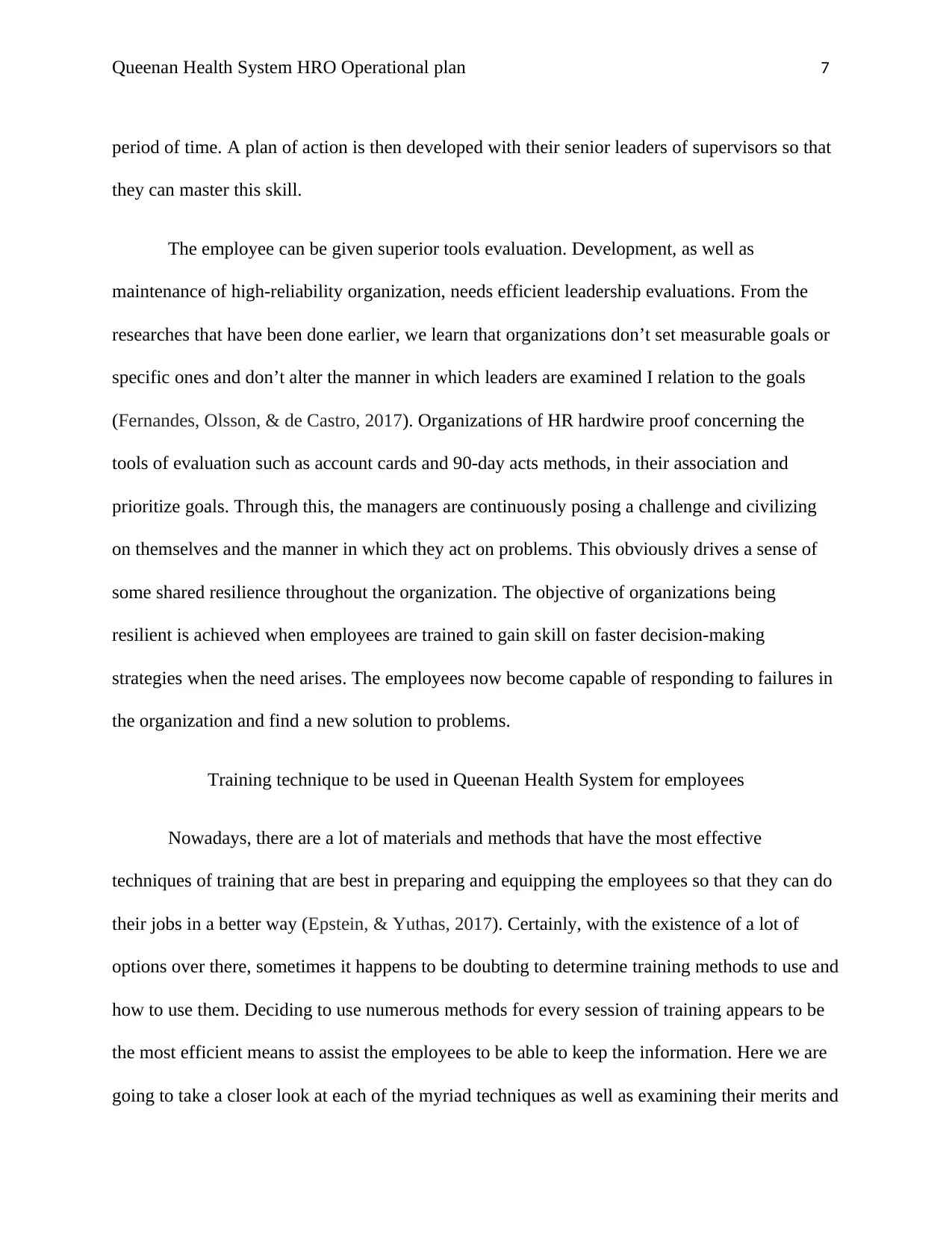
Queenan Health System HRO Operational plan 7
period of time. A plan of action is then developed with their senior leaders of supervisors so that
they can master this skill.
The employee can be given superior tools evaluation. Development, as well as
maintenance of high-reliability organization, needs efficient leadership evaluations. From the
researches that have been done earlier, we learn that organizations don’t set measurable goals or
specific ones and don’t alter the manner in which leaders are examined I relation to the goals
(Fernandes, Olsson, & de Castro, 2017). Organizations of HR hardwire proof concerning the
tools of evaluation such as account cards and 90-day acts methods, in their association and
prioritize goals. Through this, the managers are continuously posing a challenge and civilizing
on themselves and the manner in which they act on problems. This obviously drives a sense of
some shared resilience throughout the organization. The objective of organizations being
resilient is achieved when employees are trained to gain skill on faster decision-making
strategies when the need arises. The employees now become capable of responding to failures in
the organization and find a new solution to problems.
Training technique to be used in Queenan Health System for employees
Nowadays, there are a lot of materials and methods that have the most effective
techniques of training that are best in preparing and equipping the employees so that they can do
their jobs in a better way (Epstein, & Yuthas, 2017). Certainly, with the existence of a lot of
options over there, sometimes it happens to be doubting to determine training methods to use and
how to use them. Deciding to use numerous methods for every session of training appears to be
the most efficient means to assist the employees to be able to keep the information. Here we are
going to take a closer look at each of the myriad techniques as well as examining their merits and
period of time. A plan of action is then developed with their senior leaders of supervisors so that
they can master this skill.
The employee can be given superior tools evaluation. Development, as well as
maintenance of high-reliability organization, needs efficient leadership evaluations. From the
researches that have been done earlier, we learn that organizations don’t set measurable goals or
specific ones and don’t alter the manner in which leaders are examined I relation to the goals
(Fernandes, Olsson, & de Castro, 2017). Organizations of HR hardwire proof concerning the
tools of evaluation such as account cards and 90-day acts methods, in their association and
prioritize goals. Through this, the managers are continuously posing a challenge and civilizing
on themselves and the manner in which they act on problems. This obviously drives a sense of
some shared resilience throughout the organization. The objective of organizations being
resilient is achieved when employees are trained to gain skill on faster decision-making
strategies when the need arises. The employees now become capable of responding to failures in
the organization and find a new solution to problems.
Training technique to be used in Queenan Health System for employees
Nowadays, there are a lot of materials and methods that have the most effective
techniques of training that are best in preparing and equipping the employees so that they can do
their jobs in a better way (Epstein, & Yuthas, 2017). Certainly, with the existence of a lot of
options over there, sometimes it happens to be doubting to determine training methods to use and
how to use them. Deciding to use numerous methods for every session of training appears to be
the most efficient means to assist the employees to be able to keep the information. Here we are
going to take a closer look at each of the myriad techniques as well as examining their merits and
Paraphrase This Document
Need a fresh take? Get an instant paraphrase of this document with our AI Paraphraser
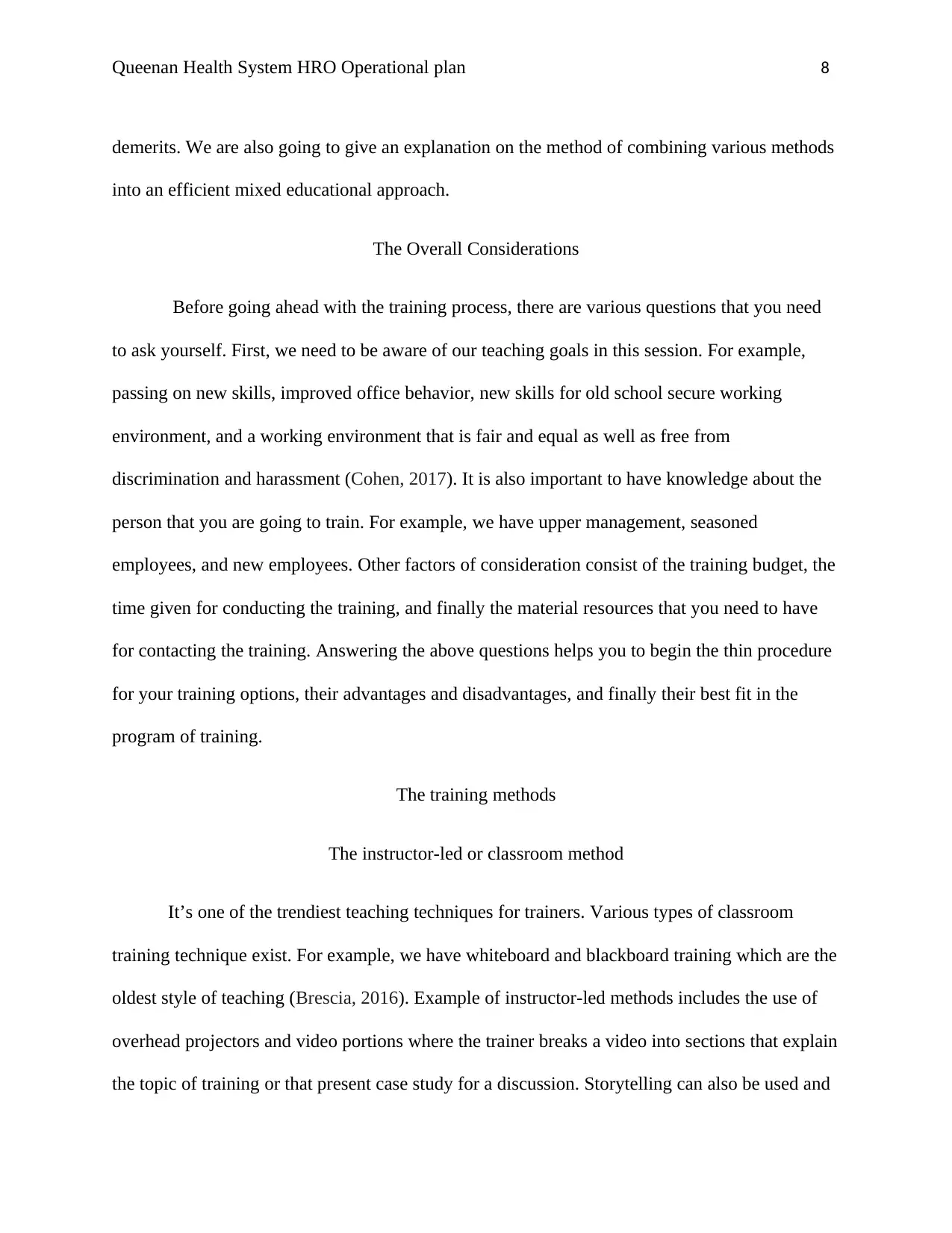
Queenan Health System HRO Operational plan 8
demerits. We are also going to give an explanation on the method of combining various methods
into an efficient mixed educational approach.
The Overall Considerations
Before going ahead with the training process, there are various questions that you need
to ask yourself. First, we need to be aware of our teaching goals in this session. For example,
passing on new skills, improved office behavior, new skills for old school secure working
environment, and a working environment that is fair and equal as well as free from
discrimination and harassment (Cohen, 2017). It is also important to have knowledge about the
person that you are going to train. For example, we have upper management, seasoned
employees, and new employees. Other factors of consideration consist of the training budget, the
time given for conducting the training, and finally the material resources that you need to have
for contacting the training. Answering the above questions helps you to begin the thin procedure
for your training options, their advantages and disadvantages, and finally their best fit in the
program of training.
The training methods
The instructor-led or classroom method
It’s one of the trendiest teaching techniques for trainers. Various types of classroom
training technique exist. For example, we have whiteboard and blackboard training which are the
oldest style of teaching (Brescia, 2016). Example of instructor-led methods includes the use of
overhead projectors and video portions where the trainer breaks a video into sections that explain
the topic of training or that present case study for a discussion. Storytelling can also be used and
demerits. We are also going to give an explanation on the method of combining various methods
into an efficient mixed educational approach.
The Overall Considerations
Before going ahead with the training process, there are various questions that you need
to ask yourself. First, we need to be aware of our teaching goals in this session. For example,
passing on new skills, improved office behavior, new skills for old school secure working
environment, and a working environment that is fair and equal as well as free from
discrimination and harassment (Cohen, 2017). It is also important to have knowledge about the
person that you are going to train. For example, we have upper management, seasoned
employees, and new employees. Other factors of consideration consist of the training budget, the
time given for conducting the training, and finally the material resources that you need to have
for contacting the training. Answering the above questions helps you to begin the thin procedure
for your training options, their advantages and disadvantages, and finally their best fit in the
program of training.
The training methods
The instructor-led or classroom method
It’s one of the trendiest teaching techniques for trainers. Various types of classroom
training technique exist. For example, we have whiteboard and blackboard training which are the
oldest style of teaching (Brescia, 2016). Example of instructor-led methods includes the use of
overhead projectors and video portions where the trainer breaks a video into sections that explain
the topic of training or that present case study for a discussion. Storytelling can also be used and
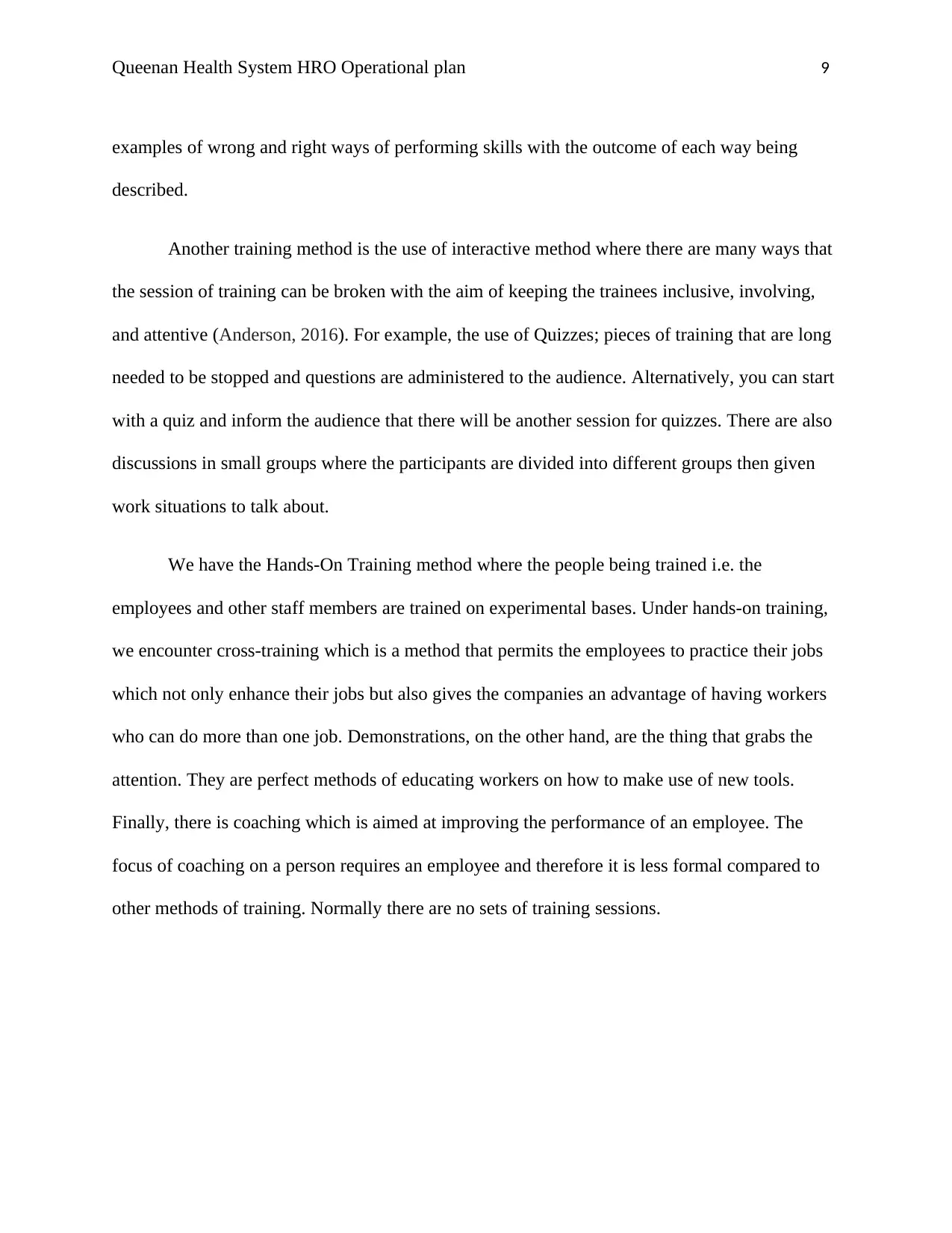
Queenan Health System HRO Operational plan 9
examples of wrong and right ways of performing skills with the outcome of each way being
described.
Another training method is the use of interactive method where there are many ways that
the session of training can be broken with the aim of keeping the trainees inclusive, involving,
and attentive (Anderson, 2016). For example, the use of Quizzes; pieces of training that are long
needed to be stopped and questions are administered to the audience. Alternatively, you can start
with a quiz and inform the audience that there will be another session for quizzes. There are also
discussions in small groups where the participants are divided into different groups then given
work situations to talk about.
We have the Hands-On Training method where the people being trained i.e. the
employees and other staff members are trained on experimental bases. Under hands-on training,
we encounter cross-training which is a method that permits the employees to practice their jobs
which not only enhance their jobs but also gives the companies an advantage of having workers
who can do more than one job. Demonstrations, on the other hand, are the thing that grabs the
attention. They are perfect methods of educating workers on how to make use of new tools.
Finally, there is coaching which is aimed at improving the performance of an employee. The
focus of coaching on a person requires an employee and therefore it is less formal compared to
other methods of training. Normally there are no sets of training sessions.
examples of wrong and right ways of performing skills with the outcome of each way being
described.
Another training method is the use of interactive method where there are many ways that
the session of training can be broken with the aim of keeping the trainees inclusive, involving,
and attentive (Anderson, 2016). For example, the use of Quizzes; pieces of training that are long
needed to be stopped and questions are administered to the audience. Alternatively, you can start
with a quiz and inform the audience that there will be another session for quizzes. There are also
discussions in small groups where the participants are divided into different groups then given
work situations to talk about.
We have the Hands-On Training method where the people being trained i.e. the
employees and other staff members are trained on experimental bases. Under hands-on training,
we encounter cross-training which is a method that permits the employees to practice their jobs
which not only enhance their jobs but also gives the companies an advantage of having workers
who can do more than one job. Demonstrations, on the other hand, are the thing that grabs the
attention. They are perfect methods of educating workers on how to make use of new tools.
Finally, there is coaching which is aimed at improving the performance of an employee. The
focus of coaching on a person requires an employee and therefore it is less formal compared to
other methods of training. Normally there are no sets of training sessions.
⊘ This is a preview!⊘
Do you want full access?
Subscribe today to unlock all pages.

Trusted by 1+ million students worldwide

Queenan Health System HRO Operational plan 10
References
Anderson, T. (2016). The Dirty War on Syria. Ottawa: Global Research.
Brescia, R. H. (2016). Uber for Lawyers: The Transformative Potential of a Sharing Economy
Approach to the Delivery of Legal Services. Buff. L. Rev., 64, 745.
Cohen, E. (2017). Employee training and development. In CSR for HR (pp. 153-162). Routledge.
Epstein, M. J., & Yuthas, K. (2017). Measuring and improving social impacts: A guide for
nonprofits, companies and impact investors. Routledge.
Fernandes, J. G., Olsson, I. A. S., & de Castro, A. C. V. (2017). Do aversive-based training
methods actually compromise dog welfare?: A literature review. Applied Animal
Behaviour Science, 196, 1-12.
Flesher, D. L., & Previts, G. J. (2016). Haskins & Sells’ Selected Papers–a profile in leadership
thought (1955–1974). Accounting History Review, 26(3), 333-350.
Giessing, J., Eichmann, B., Steele, J., & Fisher, J. (2016). A comparison of low volume'high-
intensity-training'and high volume traditional resistance training methods on muscular
performance, body composition, and subjective assessments of training. Biology of
sport, 33(3), 241.
Keown, M., Taylor, A., & Treagus, M. (Eds.). (2018). Anglo-American Imperialism and the
Pacific: Discourses of Encounter. Routledge.
References
Anderson, T. (2016). The Dirty War on Syria. Ottawa: Global Research.
Brescia, R. H. (2016). Uber for Lawyers: The Transformative Potential of a Sharing Economy
Approach to the Delivery of Legal Services. Buff. L. Rev., 64, 745.
Cohen, E. (2017). Employee training and development. In CSR for HR (pp. 153-162). Routledge.
Epstein, M. J., & Yuthas, K. (2017). Measuring and improving social impacts: A guide for
nonprofits, companies and impact investors. Routledge.
Fernandes, J. G., Olsson, I. A. S., & de Castro, A. C. V. (2017). Do aversive-based training
methods actually compromise dog welfare?: A literature review. Applied Animal
Behaviour Science, 196, 1-12.
Flesher, D. L., & Previts, G. J. (2016). Haskins & Sells’ Selected Papers–a profile in leadership
thought (1955–1974). Accounting History Review, 26(3), 333-350.
Giessing, J., Eichmann, B., Steele, J., & Fisher, J. (2016). A comparison of low volume'high-
intensity-training'and high volume traditional resistance training methods on muscular
performance, body composition, and subjective assessments of training. Biology of
sport, 33(3), 241.
Keown, M., Taylor, A., & Treagus, M. (Eds.). (2018). Anglo-American Imperialism and the
Pacific: Discourses of Encounter. Routledge.
Paraphrase This Document
Need a fresh take? Get an instant paraphrase of this document with our AI Paraphraser

Queenan Health System HRO Operational plan 11
Macnaughtan, D. (2015). The Buffyverse Catalog: A Complete Guide to Buffy the Vampire
Slayer and Angel in Print, Film, Television, Comics, Games and Other Media, 1992–
2010. McFarland.
Mescheder, L., Geiger, A., & Nowozin, S. (2018). Which training methods for GANs do actually
Converge?. arXiv preprint arXiv:1801.04406.
Mnih, V., Badia, A. P., Mirza, M., Graves, A., Lillicrap, T., Harley, T., ... & Kavukcuoglu, K.
(2016, June). Asynchronous methods for deep reinforcement learning. In International
conference on machine learning (pp. 1928-1937).
Morris, E. A. (2015). Where to put the port? The free harbor fight and the historical development
of Los Angeles. Journal of Planning History, 14(4), 263-286.
Nazir, S., Sorensen, L. J., Øvergård, K. I., & Manca, D. (2015). Impact of training methods on
Distributed Situation Awareness of industrial operators. Safety science, 73, 136-145.
Neto, L., & Batista, O. (2018). Detecção digital de doenças: estratégias de vigilância
participativa e mineração de dados em saúde no Brasil (Doctoral dissertation).
Pecorari, J. (2016). U.S. Patent Application No. 14/619,093.
Rumpf, M. C., Lockie, R. G., Cronin, J. B., & Jalilvand, F. (2016). Effect of different sprint
training methods on sprint performance over various distances: a brief review. Journal of
strength and conditioning research, 30(6), 1767-1785.
Wagner, K. D., & Ng, W. Y. (2019). Depression in Special Populations, an Issue of Child and
Adolescent Psychiatric Clinics of North America. Elsevier.
Macnaughtan, D. (2015). The Buffyverse Catalog: A Complete Guide to Buffy the Vampire
Slayer and Angel in Print, Film, Television, Comics, Games and Other Media, 1992–
2010. McFarland.
Mescheder, L., Geiger, A., & Nowozin, S. (2018). Which training methods for GANs do actually
Converge?. arXiv preprint arXiv:1801.04406.
Mnih, V., Badia, A. P., Mirza, M., Graves, A., Lillicrap, T., Harley, T., ... & Kavukcuoglu, K.
(2016, June). Asynchronous methods for deep reinforcement learning. In International
conference on machine learning (pp. 1928-1937).
Morris, E. A. (2015). Where to put the port? The free harbor fight and the historical development
of Los Angeles. Journal of Planning History, 14(4), 263-286.
Nazir, S., Sorensen, L. J., Øvergård, K. I., & Manca, D. (2015). Impact of training methods on
Distributed Situation Awareness of industrial operators. Safety science, 73, 136-145.
Neto, L., & Batista, O. (2018). Detecção digital de doenças: estratégias de vigilância
participativa e mineração de dados em saúde no Brasil (Doctoral dissertation).
Pecorari, J. (2016). U.S. Patent Application No. 14/619,093.
Rumpf, M. C., Lockie, R. G., Cronin, J. B., & Jalilvand, F. (2016). Effect of different sprint
training methods on sprint performance over various distances: a brief review. Journal of
strength and conditioning research, 30(6), 1767-1785.
Wagner, K. D., & Ng, W. Y. (2019). Depression in Special Populations, an Issue of Child and
Adolescent Psychiatric Clinics of North America. Elsevier.
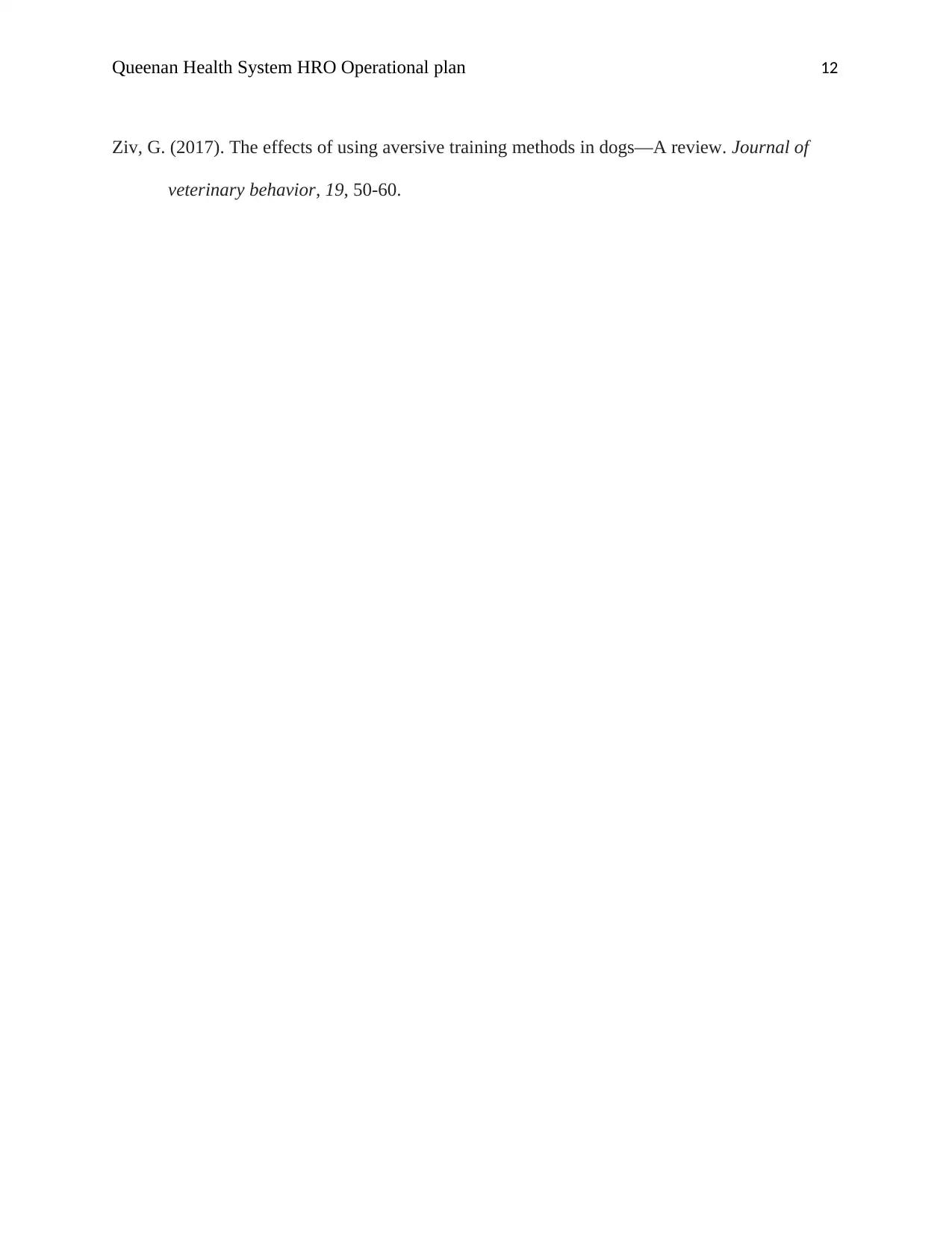
Queenan Health System HRO Operational plan 12
Ziv, G. (2017). The effects of using aversive training methods in dogs—A review. Journal of
veterinary behavior, 19, 50-60.
Ziv, G. (2017). The effects of using aversive training methods in dogs—A review. Journal of
veterinary behavior, 19, 50-60.
⊘ This is a preview!⊘
Do you want full access?
Subscribe today to unlock all pages.

Trusted by 1+ million students worldwide
1 out of 12
Related Documents
Your All-in-One AI-Powered Toolkit for Academic Success.
+13062052269
info@desklib.com
Available 24*7 on WhatsApp / Email
![[object Object]](/_next/static/media/star-bottom.7253800d.svg)
Unlock your academic potential
Copyright © 2020–2025 A2Z Services. All Rights Reserved. Developed and managed by ZUCOL.





